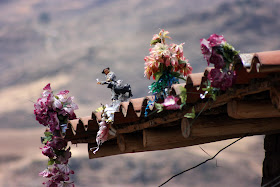A couple of Sundays ago Sarah and I went on a little jaunt
to Andahuaylillas and Huacarpay – try saying those names five times quickly!
The pronunciations, for those who are interested, in my best New Zealand
accent, are something like Arn-dar-war-li-yas and wa-ka-pai.
It’s about an hour by local bus from downtown Cusco to
Andahuaylillas, a small town that sits alongside the main road to Puno and Lake Titicaca . The town was originally founded in 1572,
as part of the Spanish plan to round up the native population and resettle them
in more easily controllable villages. It was then, and still is an agricultural
centre for the surrounding district. The men farm the Peruvian staples of maize,
potatoes and barley, while the women, even more hard-working, run the household
– which here probably means looking after cows and pigs and chickens, baking
bread and making cheese, weaving textiles, washing clothes by hand, tending to
a large, rowdy parcel of children – as well as helping their husbands on the
farm.
But Sarah and I did not visit Andahuaylillas to see cows or
pigs or peasants toiling in the fields, though it is always interesting to see
how people lead their lives. The spotlight shines on this little town, for us
and for several busloads of tourists every single day, because of the town’s
church. It is, in a word, magnificent. So magnificent, in fact, that it has
been described by such travel aficionados as TripAdvisor and Lonely Planet and
such knowledgeable institutions as the Smithsonian, as the ‘Sistine Chapel of
the Americas ’.
The front exterior of the church is currently obscured by
scaffolding, as its multi-coloured frescoes are restored, but I still managed
to squeeze between the poles to grab a couple of shots of its colourful
adornment. The interior of this church is simply breathtaking – no photos are
allowed, so you’ll just have to believe me and take these exterior shots as a miniscule
indication of the awesomeness that lies within.
Built in the early sixteenth century, the church is Baroque
in design and dedicated to St Peter the Apostle. Scenes from St Peter’s life
are illustrated in a sequence of enormous paintings that decorate the walls,
along with many stunning frescoes that date from the sixteenth and seventeenth
centuries, and a huge altar, intricate wooden carvings and ornate pictures
frames that are completely enveloped in lustrous gold leaf. With the support of
the World Monuments Fund, the church is being conserved and its wonders
protected from the ravages of time and bugs.
But the church is not Andahuaylillas’s only treasure. Very
close to the church lies a quaint little museum, containing much more ancient
riches. As well as some dusty displays with fascinating information about Inca
customs, there are mummies and skulls excavated from a local Inca site. These
exhibits are mesmerising – you could be forgiven for thinking you’d stumbled on
to the set of the Indiana Jones movie The Kingdom of the Crystal Skull and perhaps this is where screenwriter David Koepp got his
inspiration! The Inca tradition of skull manipulation, practised in the belief
that enlarging certain parts of the skull would enhance motor function and
creativity, has left us with craniums that look like they’ve come from alien
beings.
We found Anduahuaylillas a quiet little town as we wandered
its mostly empty streets. What people we encountered were friendly enough – a
couple even spoke English and one, an old woman, demanded a fee for letting me
take her photo – ah, but what a face! I may hate the wrinkles developing on my
own visage but I love to photograph them on others.
Many of the people we saw
were accompanied by the ubiquitous donkey, the favoured beast of burden here,
and were heading to the fields for a day’s labour. It was planting time so the
paddocks needed to be ploughed, and the town’s one tractor was keeping very
busy.
We also saw a lot of crosses on roof tops, some with bulls,
some without - a traditional ornament in this region (see my previous blog: There’s a bull on my roof for more information on this phenomenon). And we had a delicious, though
expensive lunch in the one restaurant that was open – tourist prices!
After a 10-minute bus ride back in the direction of Cusco , we alighted at the run-down little settlement of
Huacarpay. Many of its buildings were damaged, some literally falling apart at
the seams, others in a state of total collapse. I don’t know why this was – perhaps
from an earthquake or maybe due to severe flooding from the nearby lake – which
was the reason we stopped here. Huacarpay is most famous for its lake and
surrounding wetlands, which, supposedly, have 60 resident species of birds and
another 50 that visit in the right season. Obviously, this was not the right
season as all – and I do mean ALL – the birds had gone on holiday! The autumnal
colours of the reeds were still beautiful though and we had a pleasant stroll
along the lake’s edge. We’ll go back in the rainy season to see if the birds are back.
small.jpg)
small.jpg)
small.jpg)
small.jpg)
.JPG)
small.jpg)
small.jpg)
small.jpg)
small.jpg)
small.jpg)





small.jpg)


small.jpg)
small.jpg)
small.jpg)

small.jpg)
small.jpg)
small.jpg)
+ss+small.jpg)
small.jpg)
small.jpg)
small.jpg)
+small.jpg)
small.jpg)
small.jpg)
small.jpg)
small.jpg)
small.jpg)
small.jpg)
+small.jpg)
small.jpg)
.JPG)
small.jpg)
small.jpg)
small.jpg)
small.jpg)
small.jpg)
small.jpg)
small.jpg)
small.jpg)
small.jpg)
small.jpg)
small.jpg)
small.jpg)
small.jpg)

small.jpg)
small.jpg)
+small.jpg)
+small.jpg)